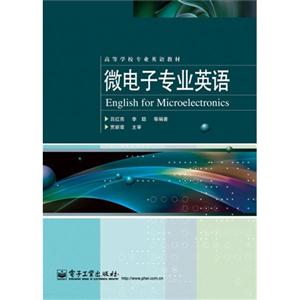目 錄
Session 1 Introduction to Semiconductor
1.1 What is Semiconductor
1.2 Classification of Semiconductor
Reading Materials
Session 2 Crystal Structure
2.1 Primitive Cell and Crystal Plane
2.2 Atomic Bonding
Reading Materials
Session 3 Band Model
3.1 Introduction to Quantum Mechanics
3.2 Band
3.3 Effective Mass Theory
Reading Materials
Session 4 The Semiconductor in Equilibrium
4.1 Charge Carriers in Semiconductor
4.2 Intrinsic Semiconductor
4.3 Extrinsic Semiconductor
Reading Materials
Session 5 Carrier Transport
5.1 Overview of Carrier Transport
5.2 Low Field Transport
5.3 High Field Transport
5.4 Diffusion Current
Session 6 Nonequilibrium Excess Carriers in Semiconductor
6.1 Recombination
6.2 Minority Carrier Lifetime
6.3 Ambipolar Transport
Reading Materials
Session 7 The pn Junction ( Ⅰ )
7.1 Introduction
7.2 Basic Structure of the pn Junction
7.3 Energy Bands for a pn Junction
7.4 Ideal CurrentVoltage Relationship
7.5 Characteristics of a Practical Diode
Reading Materials
Session 8 The pn Junction( Ⅱ )
8.1 Breakdown in pn Junction
8.2 SmallSignal Diffusion Resistance of the pn Junction
8.3 Junction Capacitance
8.4 Diffusion or Storage Capacitance
8.5 Diode Transients
8.6 Circuit Models for Junction Diodes
Reading Materials
Session 9 MetalSemiconductor Contacts
9.1 Schottky Contacts
9.2 Ohmic Contacts
Reading Materials
Session 10 Heterojunctions
10.1 Strain and Stress at Heterointerfaces
10.2 Heterojunction Materials
10.3 EnergyBand Diagrams
Reading Materials.
Session 11 The Bipolar Junction Transistor ( Ⅰ )
11.1 The Bipolar Junction Transistor Construction
11.2 Transistor Action
11.3 Nonideal Effects
11.4 Base Resistance
Reading Materials
Session 12 The Bipolar Junction Transistor ( Ⅱ )
12.1 Breakdown Voltage
12.2 Frequency Limits of BJT
12.3 The SchottkyClamped Transistor
12.4 Smallsignal Transistor Model
Reading Materials
Session 13 Basics of MOSFETs
13.1 Introduction
13.2 General Characteristics of a MOSFET
13.3 MOS System
13.4 Work Function Differences
13.5 FlatBand Voltage
13.6 Threshold Voltage
Reading Materials
Session 14 Nonideal Effects of MOSFETs
14.1 Introduction
14.2 Effective Mobility
14.3 Velocity Saturation
14.4 Channellength Modulation
14.5 DIBL
14.6 Hotcarrier Effect
14.7 GIDL
Reading Materials
Session 15 Advanced MOSFET Devices
15.1 Introduction
15.2 Channel Doping Profile
15.3 Gate Stack
15.4 Source/Drain Design
15.5 SchottkyBarrier Source/Drain
15.6 Raised Source/Drain
15.7 SOI
15.8 Three Dimensional Structure
Reading Materials
Session 16 Introduction to Integrated Circuits
16.1 Introduction
16.2 Size and Complexity of Integrated Circuits
16.3 Semiconductor Device for Integrated Circuits
16.4 IC Design Process
Reading Materials
Session 17 Analog Integrated Circuits Design
17.1 Introduction
17.2 Analog Signal Processing
17.3 CMOS Technology
17.4 Amplifiers
17.5 Differential Amplifiers
17.6 Operational Amplifiers
17.7 Characterization of Op Amps
Reading Materials
Session 18 Digital Integrated Circuits Design
18.1 Introduction
18.2 The Static CMOS Inverter
18.3 Designing Combinational Logic Gates in CMOS
Reading Materials
Session 19 Radio Frequency Integrated Circuits Design
19.1 Introduction
19.2 RF System Performance Metrics
19.3 RF Transceiver Architectures
19.4 RF Passive Component
19.5 Receiver
19.6 Frequency Synthesizer
19.7 Transmitter
Reading Materials
Session 20 Simulation and Verification
20.1 Introduction
20.2 SPICE Circuit Simulator
20.3 Circuit Design Automation with Verilog
20.4 Verification
Reading Materials
Session 21 Introduction to the Semiconductor Technology (Ⅰ)
21.1 The Development of Semiconductor Technology
21.2 Wafer Fabrication
Reading Materials
Session 22 Introduction to the Semiconductor Technology (Ⅱ)
22.1 Assembly
22.2 Metrology
Reading Materials
Session 23 Bipolar Technology and GaAs Digital Logic Process
23.1 Bipolar Technology
23.2 GaAs Digital Logic Process
Reading Materials
Session 24 CMOS Technology
24.1 CMOS Fabrication Sequence
24.2 Twin Well and Retrograde Well
24.3 Isolation
24.4 Structures that Reduce the Drain Field
24.5 Gate Engineering
Reading Materials
Session 25 Reliability
25.1 Introduction
25.2 Failure Modes
Reading Materials
參考譯文
第1講 半導體概述
1.1 什么是半導體
1.2 半導體的分類
第2講 晶體結構
2.1 原胞和晶面
2.2 原子價鍵
第3講 能帶模型
3.1 量子力學簡介
3.2 能帶
3.3 有效質量理論
第4講 平衡半導體
4.1 半導體中的帶電載流子
4.2 本征半導體
4.3 非本征半導體
第5講 載流子輸運
5.1 載流子輸運概要
5.2 低場輸運
5.3 強場輸運
5.4 擴散電流
第6講 半導體中的非平衡過剩載流子
6.1 復合
6.2 少數載流子壽命
6.3 雙極輸運
第7講 pn結(Ⅰ)
7.1 概述
7.2 pn結的基本結構
7.3 pn結的能帶圖
7.4 理想電流電壓關系
7.5 實際二極管特性
第8講 pn 結(II)
8.1 pn結擊穿
8.2 pn結的小信號擴散電阻
8.3 結電容
8.4 擴散電容(存儲電容)
8.5 二極管瞬態特性
8.6 pn結二極管的電路模型
第9講 金屬—半導體接觸
9.1 肖特基接觸
9.2 歐姆接觸
第10講 異質結
10.1 異質界面的應變與應力
10.2 異質結材料
10.3 能帶圖
第11講 雙極晶體管(I)
11.1 雙極晶體管結構
11.2 晶體管作用
11.3 非理想效應
11.4 基區電阻
第12講 雙極晶體管(II)
12.1 擊穿電壓
12.2 雙極晶體管的頻率特性
12.3 肖特基鉗位晶體管
12.4 晶體管的小信號模型
第13講 MOSFET基礎
13.1 引言
13.2 MOSFET的一般特征
13.3 MOS系統
13.4 功函數差
13.5 平帶電壓
13.6 閾值電壓
第14講 MOSFET的非理想效應
14.1 引言
14.2 有效遷移率
14.3 速度飽和
14.4 溝道調制效應
14.5 漏致勢壘降低
14.6 熱電子效應
14.7 柵感應漏極泄漏
第15講 先進的MOSFET器件
15.1 引言
15.2 溝道摻雜分布
15.3 柵疊層
15.4 源/漏設計
15.5 肖特基源/漏
15.6 提升的源/漏
15.7 SOI(絕緣層上的硅)
15.8 三維結構
第16講 集成電路簡介
16.1 概述
16.2 集成電路的面積和復雜度
16.3 集成電路中的半導體器件
16.4 集成電路設計過程
第17講 模擬集成電路設計
17.1 概述
17.2 模擬信號處理
17.3 CMOS工藝
17.4 放大器
17.5 差分放大器
17.6 運算放大器
17.7 運放的特點
第18講 數字集成電路
18.1 介紹
18.2 靜態CMOS反相器
18.3 CMOS組合邏輯門的設計
第19講 射頻集成電路設計
19.1 概述
19.2 射頻系統的性能指標
19.3 射頻收發機的結構
19.4 無源射頻元件
19.5 低噪聲放大器
19.6 頻率合成器
19.7 發射機
第20講 仿真與驗證
20.1 簡介
20.2 SPICE電路仿真器
20.3 使用Verilog進行電路的自動設計
20.4 驗證
第21講 半導體技術簡介(Ⅰ)
21.1 半導體技術的發展
21.2 晶片制造
第22講 半導體技術簡介(Ⅱ)
22.1 組裝
22.2 測量
第23講 雙極技術和砷化鎵數字邏輯工藝
23.1 雙極技術
23.2 砷化鎵數字邏輯工藝
第24講 CMOS工藝
24.1 CMOS制造流程
24.2 雙阱和倒摻雜阱
24.3 隔離
24.4 降低漏端電場的結構
24.5 柵工程
第25講 可靠性
25.1 概述
25.2 失效模型
參考文獻
















